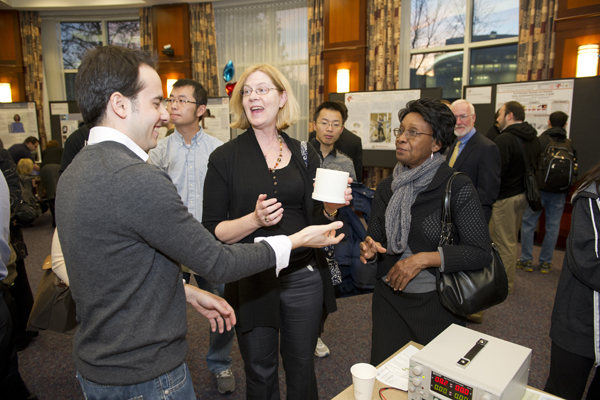‘Popping in’ on the latest research

A young man’s hand movements and body temperature are being tracked as he gesticulates while discussing his research with another student. Elsewhere in the room, someone stares at a computer screen while wearing a cap connected to dozens of electrodes. Next to him, someone else handles a cup outfitted with an internal gyroscope.
This was the scene in Raytheon Amphitheater on Monday evening at Northeastern’s third Pop Up Open Lab Experience & Reception, where the university community had the opportunity to put some of the personal and interactive health devices being developed in Northeastern labs to the test.
The open labs, sponsored by the Office of the Provost, bring the Northeastern community together to learn about colleagues’ research in an informal and interactive setting. The events can also spark new, interdisciplinary education and research initiatives and collaborations.
Mechanical and industrial engineering associate professors Andrew Gouldstone and Rifat Sipahi displayed a device that aims to help patients with Parkinson’s disease handle a cup full of liquid with more ease and control. The prototype cup contains a gyroscope in its base that offsets the directional force of the tremor in a patient’s hand. The team is also working on other devices to help Parkinson’s patients, including various technologies to improve their ability to write, Sipahi explained.
Maciej Pietrusinski, a postdoctoral researcher in mechanical and industrial engineering distinguished professor Dinos Mavroidis’ lab, is developing a much larger device to help stroke patients regain their ability to walk with a normal gait. The current therapy is very labor and resource intensive and requires at least two physical therapists, he said. Yet his treadmill-based robotic gait rehabilitation system allows patients to get the benefits of a therapy session in their own homes, any time of day.
Physical impairments, though, aren’t the only areas where health technologies are valuable. Personal health informatics PhD candidate Miriam Zisook is working with Matthew Goodwin, assistant professor of health sciences and computer and information sciences, to understand the nonverbal cues generated by autistic children. Zisook explained that these patients’ frustrated attempts at communication are often mistaken as violent misbehavior. So if the behaviors an autistic child uses to get someone’s attention could be identified earlier, perhaps they’d be less likely to escalate into “acting out.”
Goodwin’s lab uses sensors to monitor repetitive motion, body temperature and other nonverbal indicators of stress, which can be used for both research purposes and in the development of communication tools like those Zisook envisions.

Deniz Erdogmus’ lab develops brain computer interfaces to help locked-in patients communicate with the power of their minds. Photo by Brooks Canaday.
[media-credit name=”Brooks Canaday” align=”alignleft” width=”350″][/media-credit]Electrical and computer engineering associate professor Deniz Erdogmus’ lab is also interested in communication devices. His group develops brain computer interfaces to help locked-in patients spell out sentences and interact with the world, a task that would otherwise be impossible.
This new era of healthcare technology also has the unique capacity to promote wellness among the healthy. Computer and information sciences associate professor Timothy Bickmore develops virtual health advocates to promote positive behavior across demographics, with a particular eye toward those with limited health and computer literacy. Stephen Intille, associate professor of health sciences and computer and information sciences, uses real-time sensors and handheld mobile devices to build applications that promote exercise and healthy eating.
From helping a Parkinson’s disease patient who is struggling with tremors to making it easier for those hoping to lose weight after the holidays, the event made it clear there is much to gain from the next generation of healthcare technology.





